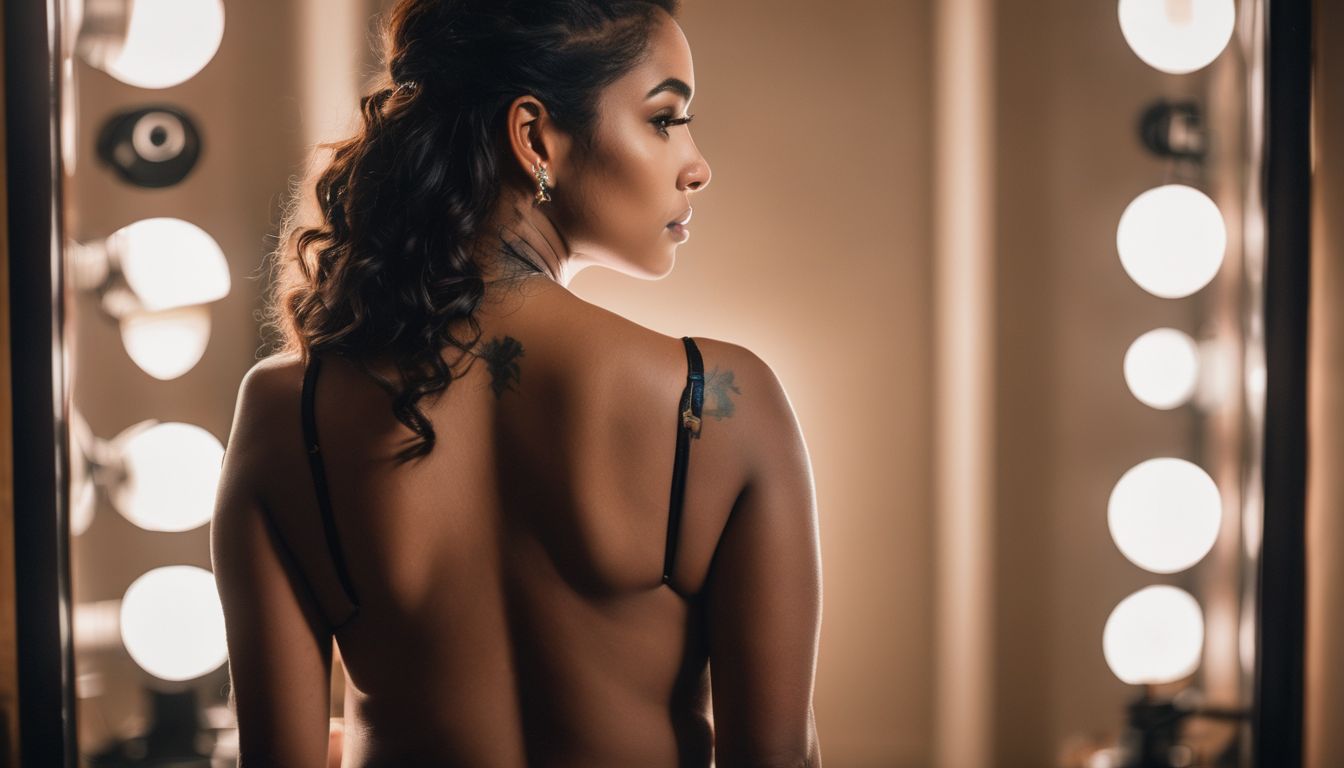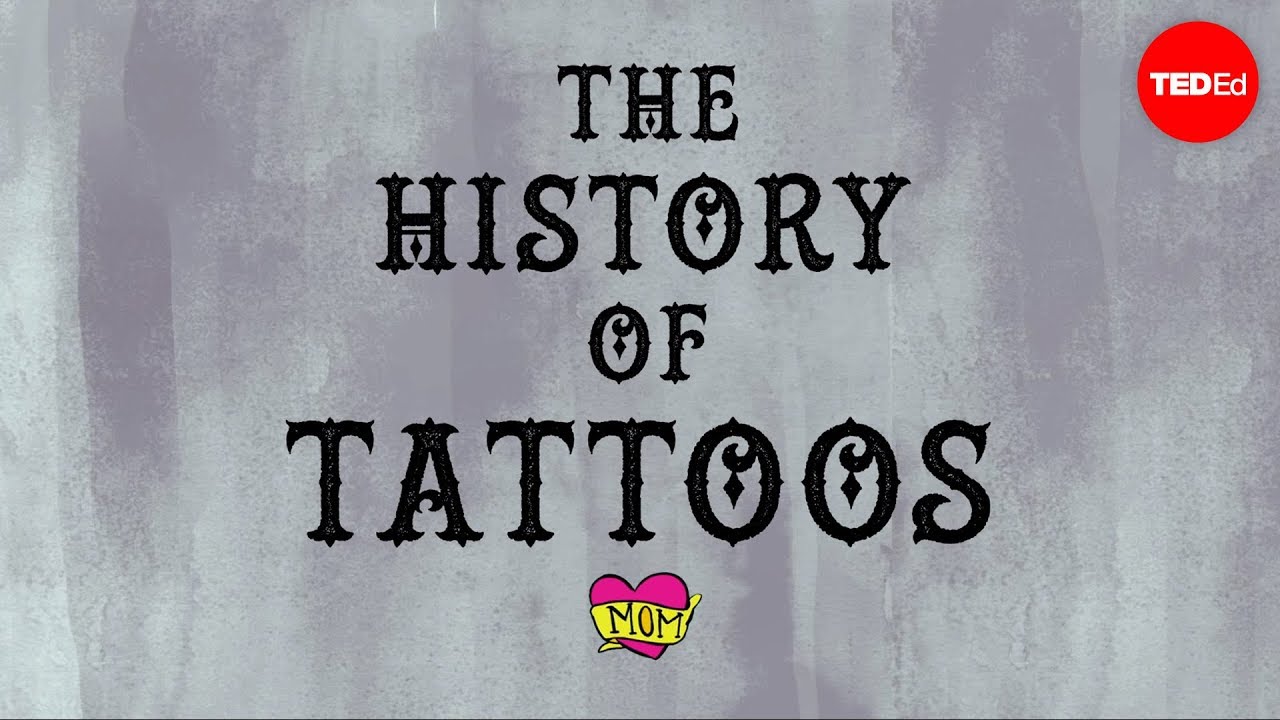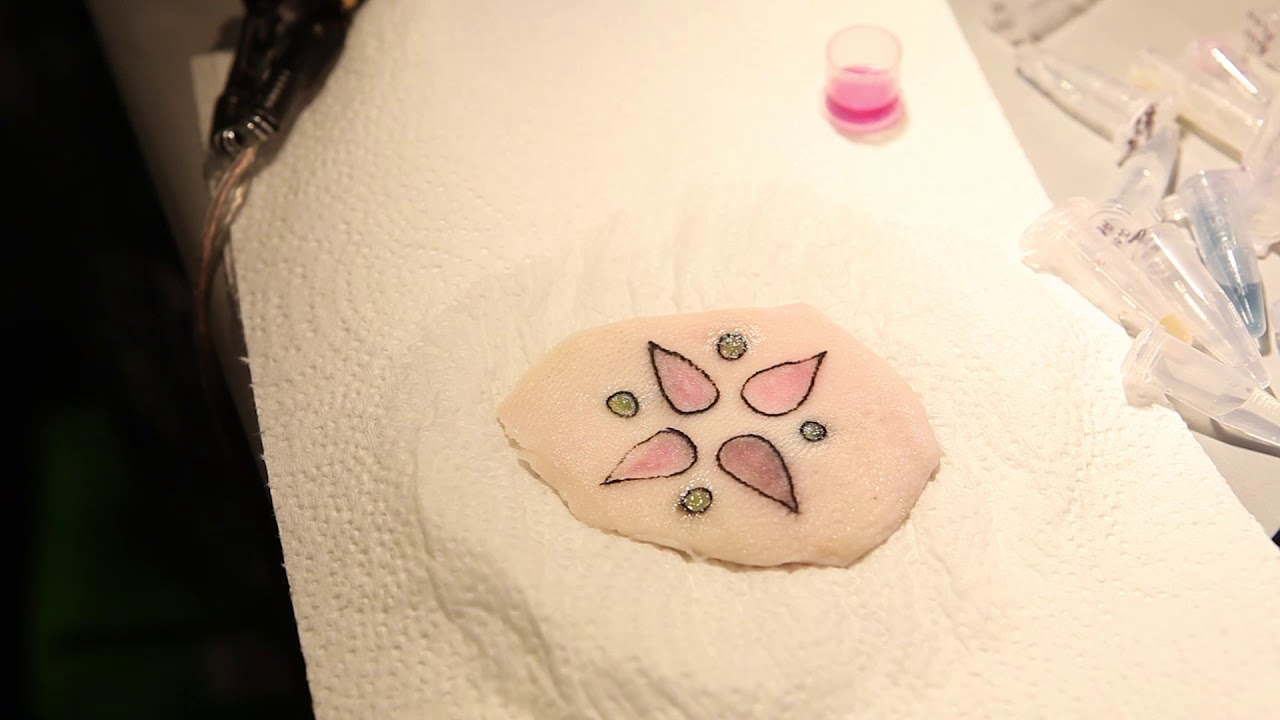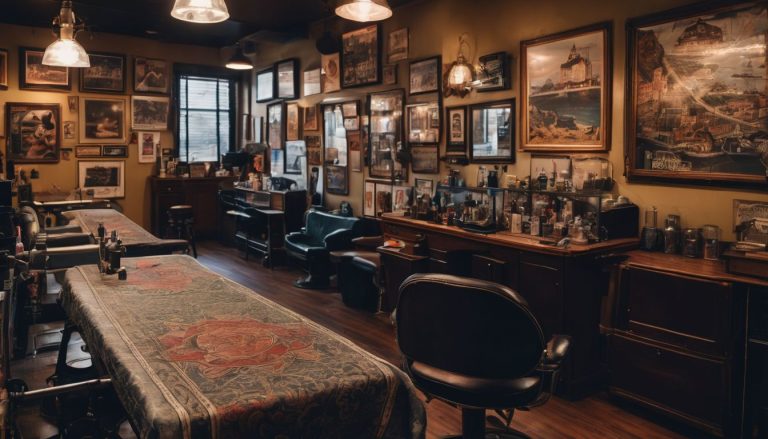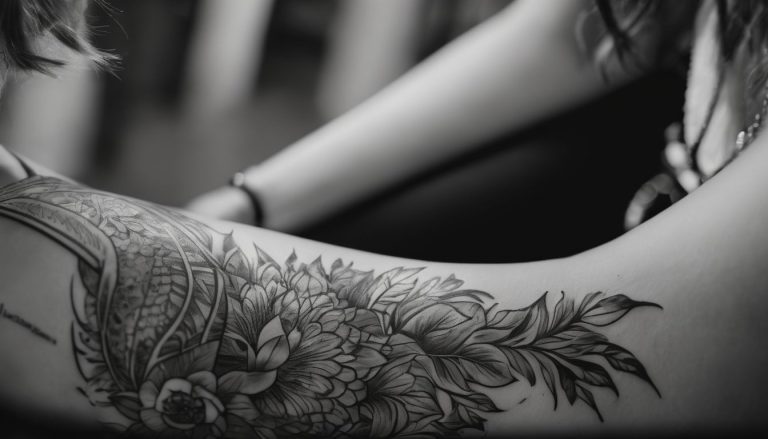The Evolution of Lower Back Tattoos: From Pop Culture Trend to Symbol of Female Empowerment
Create your own unique tattoos and art for your home
Many people have strong opinions on tattoos, especially when ink graces the lower back. Once a pop culture craze, lower-back tattoos had their fame peak in the early 2000s. This blog post will explore how these designs went from a fashion statement to powerful symbols of female empowerment, offering insight for those rethinking this body art.
Keep reading and discover the transformation of an iconic tattoo trend!
Key Takeaways
- Lower back tattoos, started as a trend in the early 2000s influenced by celebrities, are symbols of female empowerment today.
- Stereotypes labeled them as “tramp stamps,” but women now choose designs that reflect personal strength and individuality.
- Risks such as infection or allergic reactions exist with lower back tattoos, so safety precautions must be taken when getting inked.
- The media plays a role in shifting perceptions by showcasing tattoos on influential women as positive representations of strength and confidence.
- Women have pushed past societal stigmas around body art, using lower back tattoos to express autonomy and challenge gender norms.
History of Lower Back Tattoos
Lower back tattoos, also known as lumbar tattoos, became popular in the early 2000s and were heavily influenced by female celebrities. However, they were often associated with negative stereotypes and misconceptions, leading to a shift in perception over time.
Popularized in the early 2000s
In the early 2000s, lower back tattoos became a significant trend that coincided with fashion trends like low-rise jeans and visible thong straps. High-profile female celebrities flaunted their lumbar tattoos, inspiring countless fans to embrace this pop culture body art as a fashionable statement.
These trendy lower back designs often featured flowers, tribal patterns, and cultural symbols that captured the spirit of the era.
The allure of these feminine lower back tattoos extended beyond mere aesthetics; they also represented seductive feminine power. As lumbar ink gained visibility in media and fashion, it played an essential role in shaping attitudes towards body art.
The next section delves into how societal perceptions have evolved from viewing these tattoos as taboo to celebrating them as empowering symbols for women.
Influence of female celebrities
During the early 2000s, female celebrities played a significant role in popularizing lower-back tattoos. Influential personalities like Britney Spears and Angelina Jolie prominently showcased their lower-back tattoos, leading to a surge in its trendiness among the general public.
As these influential figures proudly displayed their body art, it became synonymous with confidence and self-expression for women around the world. The impact of female celebrities embracing lower-back tattoos contributed to them being viewed as fashionable and empowering symbols rather than mere fashion accessories.
The endorsement of lower-back tattoos by high-profile female celebrities not only elevated its status but also sparked conversations about body autonomy and personal empowerment. This shift encouraged women to embrace their bodies’ artistry and establish solidarity through shared experiences of self-expression, further breaking societal norms related to femininity and individuality.
Misconceptions and stereotypes
Misconceptions and stereotypes have historically surrounded lower-back tattoos, often labeling them as “tramp stamps” and associating them with promiscuity. However, these negative perceptions fail to acknowledge the evolving cultural significance of lower back ink.
While popularized in the early 2000s by female celebrities and influencers, misconceptions about lower-back tattoos have perpetuated outdated views that disregard their potential for empowerment and self-expression.
Over time, this style of body art has transformed from a symbol associated with seduction to one embraced by women as a form of personal empowerment. As society continues to shift towards embracing body art and self-expression, it’s crucial to recognize the changing perception of lower-back tattoos as symbols of feminine strength and autonomy.
Changing Perception of Lower Back Tattoos
Lower back tattoos have transformed from being seen as a taboo or tramp stamp to becoming symbols of empowerment and self-expression for women. Examples of empowering lower back tattoos will be discussed in this section, shedding light on the shift in perception and meaning behind these once controversial body arts.
From taboo to empowerment
The perception of lower-back tattoos has evolved from being taboo to symbolizing female empowerment. Women have reclaimed this form of body art, transforming it into a representation of personal strength and self-expression.
The shift in attitude reflects a broader cultural movement towards embracing women’s autonomy and challenging traditional stereotypes.
This transformation has redefined the meaning behind lower-back tattoos, aligning them with feminist symbolism and empowering individuals to embrace their bodies as a form of self-expression.
Examples of female empowerment tattoos
The shift from taboo to empowerment has led to an increase in female empowerment tattoos. These tattoos often carry symbolic meanings that reflect a woman’s strength, resilience, and self-expression.
- Warrior symbols, such as shields or swords, represent inner strength and courage in overcoming life’s obstacles.
- Depictions of goddesses or mythical female figures symbolize the embrace of femininity and divine power.
- Tattoos featuring phrases or quotes related to empowerment and independence serve as daily reminders of a woman’s worth and capabilities.
- Floral designs with vibrant colors signify growth, beauty, and the ability to thrive even in challenging environments.
- Animal motifs like lions or wolves embody traits of confidence, leadership, and fearlessness – qualities that are often associated with female empowerment today.
- Geometric patterns or mandalas are used to symbolize balance, wholeness, and the interconnectedness of mind, body, and spirit.
- Nature – inspired elements such as trees or birds evoke themes of freedom, renewal, and the interconnectedness between women and nature.
- Artistic renditions of cultural symbols from different heritages promote inclusivity and celebrate diversity while recognizing historical legacies of strength and resilience.
Medical Aspects of Lower Back Tattoos
Lower back tattoos, while popular and empowering, also come with potential risks and complications. It is important for individuals to be aware of safety precautions and the medical implications before getting inked in this area.
Potential risks and complications
Tattooing the lower back carries potential risks and complications, including infection, allergic reactions to ink, and scarring. These tattoos require proper care during the healing process to prevent infections that could lead to serious health issues.
Additionally, improper sterilization of equipment poses a risk of transmitting blood-borne diseases such as hepatitis B and C or HIV. It’s crucial to choose a reputable tattoo artist who follows strict safety precautions and uses sterile tools and high-quality ink.
Despite these risks, many women continue to embrace lower-back tattoos as a form of self-expression and empowerment. As with any body modification, being well-informed about the possible dangers allows individuals to make educated decisions when getting inked.
Safety precautions
Before getting a lower back tattoo, consult with a professional tattoo artist.
How Lower Back Tattoos are Portrayed in Pop Culture
Lower back tattoos have been influential in shaping fashion and media, with numerous celebrities sporting this popular body art. Their portrayal in pop culture has played a significant role in the evolution of lower back tattoos as a symbol of female empowerment.
Influence on fashion and media
Lower back tattoos have significantly influenced fashion trends, with their popularity spreading through celebrity endorsements and media exposure. Celebrities sporting lower-back tattoos have been featured in magazines and on television, contributing to the widespread adoption of this trend among women.
The cultural significance of these tattoos has also been reflected in fashion designs, with various clothing and accessory lines incorporating elements reminiscent of lower-back tattoo designs.
As a result, these tattoos have become more than just body art – they have become a unique form of expression that transcends traditional fashion boundaries.
The media has played a pivotal role in reshaping the perception of lower back tattoos by highlighting their association with female empowerment. Through positive portrayals in movies, music videos, and social media platforms, lower-back tattoos are increasingly being celebrated as symbols of strength and confidence rather than being stigmatized as provocative or inappropriate.
Celebrities with lower back tattoos
- As the trend of lower – back tattoos gained momentum in the early 2000s, female celebrities embraced this fashion statement, contributing to its popularity.
- Angelina Jolie, known for her large stylized dragon tattoo, showcased the appeal of lower – back tattoos as a symbol of strength and femininity.
- Britney Spears’ fairy tattoo sparked widespread interest in this body art style, reflecting a blend of delicacy and empowerment.
- Rihanna’s striking Maori – inspired design exemplifies the fusion of cultural symbolism with modern reinterpretation in lower back tattoos.
- Megan Fox has a prominent quote inked on her lower back, illustrating how these tattoos can serve as personal expressions of empowerment.
The Reemergence of Lower Back Tattoos as a Symbol of Female Empowerment
Women have reclaimed lower back tattoos as a symbol of empowerment, with many choosing designs that hold personal significance and reflect their journey of self-expression. This shift in perception has sparked a cultural movement challenging previous stereotypes and embracing the beauty of women’s body art.
Rise in popularity among women
The resurgence of lower-back tattoos among women has been notable in recent years, marking a shift away from the previous stereotypes associated with these tattoos. In the past, they were often labeled as “tramp stamps” and viewed in a negative light.
However, contemporary women are reclaiming this form of body art as a symbol of empowerment and self-expression. This cultural shift reflects a broader movement towards embracing individuality and rejecting societal judgments about body ink.
Women are choosing to adorn their lower backs with meaningful designs that speak to their personal stories and journeys, challenging traditional norms about femininity and beauty.
As more women proudly display their lower-back tattoos, it is evident that these once stigmatized symbols have evolved into powerful statements of autonomy and confidence. The popularity of lower-back tattoos among women signifies an embrace of self-expression without conforming to outdated societal standards.
Representation in the media
The rise in popularity of lower back tattoos among women has been mirrored in the media, with an increasing number of influential figures proudly displaying their symbolic body art.
Celebrities and public figures have played a significant role in portraying lower back tattoos as empowering and meaningful, challenging the outdated stereotypes associated with them.
This representation has helped reshape societal perceptions and highlight the evolving cultural significance of these tattoos, emphasizing their role as a form of female empowerment rather than mere fashion statements.
Breakdown of societal stereotypes and perceptions
Societal stereotypes and perceptions of lower-back tattoos have shifted from negative connotations to a symbol of female empowerment. Previously considered as “tramp stamps,” these tattoos faced stigma and were associated with promiscuity.
However, there has been a significant movement to reclaim the meaning behind lower-back tattoos, redefining them as empowering symbols of self-expression and autonomy. Women have embraced this form of body art as an assertion of their individuality and strength, challenging societal misconceptions and promoting a new cultural narrative around lower-back tattoos.
The evolution of societal stereotypes regarding lower-back tattoos mirrors broader cultural shifts towards embracing women’s autonomy and self-expression through body art. As more women choose to get lower-back tattoos, they are breaking free from traditional gender expectations and asserting their right to make choices about their bodies.
Conclusion
In conclusion, the lower back tattoo has experienced a significant evolution from a pop culture trend to a symbol of female empowerment. Women are reclaiming and redefining this form of body art, transforming it into a representation of their autonomy and self-expression.
The resurgence of lower-back tattoos reflects broader cultural shifts toward embracing body art as well as challenging traditional perceptions. As women continue to embrace these empowering tattoos, they are making a statement about their individuality while celebrating the diverse meanings behind their chosen designs.
These symbolic inkings also reflect the ongoing journey towards breaking down gender-based stereotypes associated with body art.
FAQs
1. How have lower back tattoos changed over time?
Lower back tattoos have evolved from a pop culture trend often seen in celebrities to a powerful symbol of female empowerment and self-expression.
2. Why do women choose tattoos on their lower spine?
Women may choose lower spine tattoos because they can be both fashionable and symbolic, offering a personal touch of empowerment that feels unique to their body ink.
3. Can you tell me what some tattoo meanings are for lower back ink?
Yes, the symbolism in tattoos varies widely, but many people get empowering female tattoos with designs that represent strength, independence, or personal transformation.
4. Has the view of lower back tattoos shifted in tattoo culture?
Indeed! Once viewed as just trendy body art, these days, the cultural evolution in body art recognizes lowerback ink as a form of self-expression linked to women’s empowerment.
5. Are fashionable lower-back tattoos still influenced by celebrities?
While celebrity-inspired body art has played a role in popularizing certain designs, many individuals now seek out meaningful and symbolic body ink that reflects their own experiences and values.

